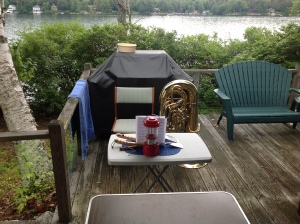Last week I saw Harry Watters perform an absolutely wonderful recital at the Eastern Trombone Workshop at Fort Myer in Arlington, VA. He titled the recital “A Tribute to Carl Fontana” and was joined by four colleagues to fill out a jazz combo. It was truly an incredible hour of music, especially considering the fact that it was at 10:00 AM!

There were many things to be impressed by at this recital. When you closed your eyes, you swore that you were listening to Fontana himself, live and in the flesh. Harry’s doodle tongue is perfect, his slide technique is textbook and his phrasing is clear and brilliant. But there is one thing not on that list that I keep thinking about some four days later: his vibrato.
Harry’s vibrato is really incredible and one of the best I’ve ever heard from a brass player. The jazz style that he was playing in features a lot of slide vibrato and he executed it to perfection. Listening to Harry’s vibrato reminded me that there are four basic variables in the effective use of vibrato:
- The width of the vibrato.
- The speed of the vibrato.
- When you start the vibrato.
- When you end the vibrato.
A great question to ask yourself as a player: do I always use the same width of vibrato? The same speed? Am I always predictable as to when I begin my vibrato? If you are Harry, the answer to these three questions is no. Within one recital, all within the same style of music and all while imitating the same artist the entire time, he had variety to all three of these parameters.
The vibratos of the late, great Roger Voisin of the Boston Symphony and that of Chris Martin of the Chicago Symphony are amazingly different in both their speed and width. Studying all different kinds of vibrato is essential for any student to develop their own voice in this department. That study, for the record, begins and ends with singers. They are who we all try to emulate, period.
It has been my experience that many students use vibrato on any and all long notes when they are attempting to play musically. Vibrato is a wonderful tool for making a long note interesting (one of the best in fact,) but to my ears having a vibrato which is always predictable really robs it of most of its effectiveness.
There were long notes when Harry waited a long time before adding vibrato which created a real sense of tension. There were also some longer notes where he ended the vibrato before he got to the conclusion of the note, ending it with straight tone. This also has a really magical effect when done right.
But there was one note that really registered with me and is the note that inspired this blog post. During one of his jazz ballads, there was a long note that was screaming for vibrato. He had already proven to me that I didn’t know when he was starting the vibrato, when he was ending it or the speed and width of it. He already had me “leaning forward” in my chair in anticipation.
With this long note in particular, he waited, and waited, and waited, and finally the note ended and the vibrato never came. He went on to the next phrase without using the vibrato that I was specifically waiting for. What an effect! It was very moving.
So Harry taught me something last Friday morning. In addition to the four points above to consider when using vibrato I now consider a fifth: should I even use vibrato on any particular note, even if the entire rest of the tune features it. I’ve been thinking about it ever since.


